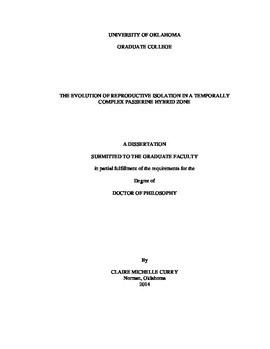| dc.contributor.advisor | Patten, Michael | |
| dc.contributor.author | Curry, Claire Michelle | |
| dc.date.accessioned | 2014-03-12T15:45:23Z | |
| dc.date.available | 2014-03-12T15:45:23Z | |
| dc.date.issued | 2014 | |
| dc.identifier.uri | https://hdl.handle.net/11244/7983 | |
| dc.description.abstract | Understanding the relative importance of reproductive isolating barriers between populations allows us learn what processes are most prevalent in causing speciation. Hybrid zones, where distinguishable populations interbreed, are particularly good systems in which to study how isolating barriers evolve because of the interaction between populations with incomplete reproductive isolation. Examining a hybrid zone over time or with contacts of different ages allows us to sort out which comes first—selection against hybrids, innate preferences for hybrid or parental types, or if one barrier type additionally evolves as a result of the other. One such temporally complex hybrid zone is that of two oscine songbirds, the Black-crested (Baeolophus atricristatus) and Tufted (B. bicolor) Titmice (family Paridae) in the southern Great Plains of North America; they differ in song, plumage, and genetics. In Texas, the two populations have been interbreeding for several thousands of years across a natural ecotone, while in Oklahoma the two species have contacted within the past century. Few studies examine multiple contacts within one species complex to compare how selection has changed their extent and behavioral interactions over time. I first discuss general patterns of selection in hybrid zones and then examine in titmice (1) how morphology and plumage change across the hybrid zone in the younger and older regions; (2) patterns of and potential mechanisms causing song variation; (3) genetic introgression and genetic signatures of recent range expansion; and (4) sexual selection on males and females and reproductive fitness of hybrids. My data suggest that ongoing interactions have resulted in a stable older zone where parental species prefer conspecific song and plumage and a younger zone with the potential for continuing
xxv
introgression of plumage and genes, as there are currently few preferences by males or females for song or plumage. These data best match a tension zone model (selection against hybrids), but intrinsic postmating isolation appears to be absent even in the older part of this system. Future studies should focus on potential ecological or behavioral post-mating isolation barriers that prevent the region of hybridization from spreading and that could cause the younger zone to evolve increased pre-mating isolation barriers such as those found in the older zone. | en_US |
| dc.language | en_US | en_US |
| dc.subject | Biology, General. | en_US |
| dc.title | The Evolution Of Reproductive Isolation In A Temporally Complex Passerine Hybrid Zone | en_US |
| dc.contributor.committeeMember | Broughton, Richard | |
| dc.contributor.committeeMember | Elisens, Wayne | |
| dc.contributor.committeeMember | Hoagland, Bruce | |
| dc.contributor.committeeMember | Wellborn, Gary | |
| dc.date.manuscript | 2014-03 | |
| dc.thesis.degree | Ph.D. | en_US |
| ou.group | College of Arts and Sciences::Department of Biology | |
